Lately I’ve developed a bit of an obsession about Macedonian bronze shields (chalkaspides). The Antigonids and Seleucids both had units named after these brazen shields and given the prevalence of artistic evidence, I suspect they were universal during the Hellenistic period. In this post I show 24 bronze shield designs, The Balagan Collection of Macedonian Bronze Shield Designs.
Evidence for Macedonian shield designs
We have a few Macedonian shields recovered by archeologists from tombs. This material evidence is supplemented by paintings, mosaic derivatives of paintings, sculpture, coins, and pottery. Archeology has uncovered a single limestone shield former; this Ptolemaic piece is held by the Allard Pierson Archaeology Museum, Amsterdam. That shield former convinces me the phalangites carried mass produced wooden shields with a moulded bronze surface. There is evidence for painted Macedonian shields (Karunanithy, 2013; Sekunda, 1984, 2012, 2013), but I suspect these were cavalry and/or elite shields and I’ll cover them some other time.
Macedonian shields feature concentric patterns with crescent and the sun motif (Head, 1982; Karunanithy, 2013). The sun could be have four, eight, 12 or 16 rays. The centre of a shield design was often a disc, which could be blank or contain a device such as the sun (the Macedonians were big on the sun), torch, spearhead, double-headed axe, thunderbolt, Heracles club, staff of Hermes, Kings, deities or mythical personalities (Gorgon’s head, Heracles head).
On page 113 of Duncan Head’s book on the Macedonian and Punic Wars are twenty black and white images of Macedonian shields (Head 1982, Figure 40). 16 of those are candidates for bronze shields and I’ve reproduced them in colour here. I’ve added four more bronze shields that I thought were interesting, bringing the total back to 20. But then I got all keen and added another 4 because I wanted to include some from the reign of Alexander III ‘the Great’.
The shields
So here are my 24 bronze shields, in colour. I’m not artistic, just a computer mechanic. So don’t expect art. I’ve used simple tools to give a sense of what these “brazen and glittering bucklers” would have looked like.
I always admired the page of shield in Duncan Head’s book (Head, 1982, fig. 40) so I’ve used a similar layout. My shields cover from the period before Philip II of Macedon, through Alexander, the Antigonids, the Seleucids, Ptoloemaics, Pergamene, and end with the Roman puppet state of Macedonia Prima.

B01 (40a): ~375 BC Macedonian Clay Model
This design is based on shield 40a from Head (1982). Head says it is based on a clay model from Macedonian tomb, 4th Cent. Head says it probably pre-dates Phillips reforms as has a rim making it a hoplite shield. I’ve chosen to replace the rim with a concentric circle as per later shields.

B02: ~336 BC Large Larnax – 16 Ray Vergina Sun
The large Macedonian tomb ‘of Philip II’ contained two gold larnax. These are on display at Museum of the Royal Tombs at Aigai, Vergina, Greece.
The larger gold larnax has a Macedonian Sun with 16 rays. This shield is speculative and bears the same 16 ray star.
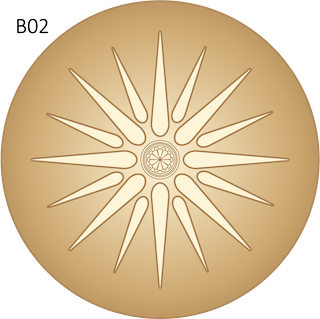
B03: ~336 BC Small Larnax – 12 Ray Vergina Sun
The smaller gold larnax from The large Macedonian tomb ‘of Philip II’ has a Macedonian star with only 12 rays. This shield is speculative and bears the same 12 ray star.
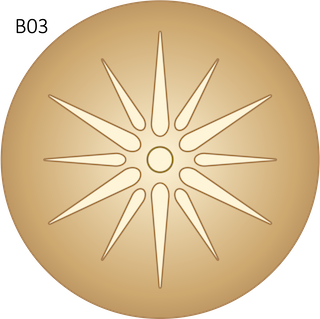
B04 (40b): 335-315 BC Coins of Patraios – Pantodapoi
This design is based on shield 40b from Head (1982). Head says this is from the coins of Patraios of Paionia, probably Alexander’s contemporary. It is carried by an infantryman, in trousers and helmet, who is ridden down by a Paionian cavalryman. Merker associates it with the killing of a Persian officer by Ariston, leader of Alexander’s Paionians; but this Persian was a cavalry officer. The victim’s combination of trousers and Macedonian blazon may mean he is a Persian in Macedonian employ and the coin relates to an otherwise unknown incident in the wars of the Successors. I think this makes the shield suitable for Pantopodoi.

Note: I got lazy and used squares rather than pellets for the outside ring.
B05: 325-302 BC Alexander III ‘the Great’ – Torch
I have based this shield on a Macedonian helmet-shield coin from the time of Alexander III ‘the Great’. It bears one of the common Macedonian motifs, a torch.

B06: After 334 BC Alexander III ‘the Great’ – thunderbolt
This shield is also based on a Macedonian helmet-shield coin from the time of Alexander III ‘the Great’. In this case the shield bears a thunderbolt.

B07: 325-302 BC Alexander III ‘the Great’ – Caduceus
The third of my shields of Alexander III ‘the Great’ is from a Macedonian helmet-shield coin bearing the staff of Hermes (Caduceus). The coin was struck 325-302 BC.

B08 (40c): ~300 BC Coins of Ialysos
This design is based on shield 40c from Head (1982). Head says it is from the coins of Ialysos, Ialysos possibly being a tyrant of Iasos n Caria c 300. Head notes the centre device is uncertain because the shield is shown in three-quarter view. But it is clear the coins represent a concave rimless Macedonian infantry shield.
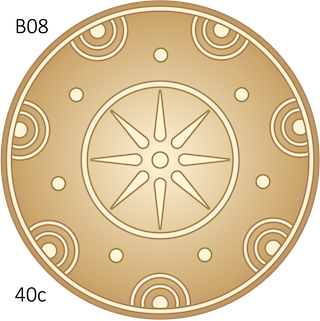
B09: ~300 BC Ptolemaic Shield Former – gorgoneion
Mestre Gonzalez (2021) includes a bronze coin from Miletos, struck by Asandros under Philip III Arrhidaios ca. 323-319 BC. This has a Macedonian shield with a gorgoneion – a representation of a gorgon’s head – on the boss on the obverse and a Macedonian helmet and a labrys on the reverse. In fact this pattern common as a coin as the Gorgon was somehow associated with kingship.
Unusually we have discovered a Hellenistic limestone mould for such a shield from Ptolemaic Egypt. This mould is housed in the Allard Pierson Archaeology Museum, Amsterdam. From what I can tell the crescents and stars are offset by 7 degrees from the normal vertical alignment.
A shield with Medusa’s head in the middle shows that portraits were possible in the centre of Macedonian shields.

B10 (40d): 279 BC Aitolian coins
This design is based on shield 40d from Head (1982). Head used Aitolian coins to derive the shield. The coins show a trophy along with Celtic shields of the victory of 279; it may be Macedonian shield looted by a Galatian, or have been carried by the Celt’s Thessalian allies.
Personally I think it is very similar to to B11 (40f) which is Antigonid Macedonian.
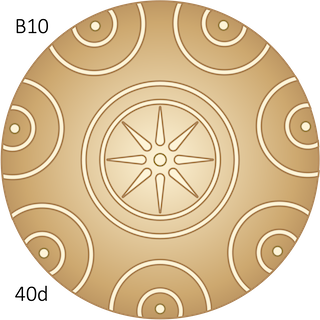
B11 (40f): ~ 279 BC Antigonid – Gonatas II’s Marriage
This design is based on shield 40f from Head (1982). Head explains this is from a painting celebrating Antigonus II Gonatas’s marriage in 279; it is polished bronze with the design in relief. So far I haven’t found the “painting celebrating Gonatas’s marriage”.
The same shield, or a very similar one, is shown in a fresco of the Villa Fannius, c. 40 BC,. The fresco is believed to show Antigonus II Gonatas and his mother Phila. The shield is leaning against Gonatas. The fresco now resides in the Archaeological Museum of Naples.
Personally I think this is very similar to B10 (40d). The Aitolian coins date from a similar time to Gonatas’s marriage.

B12(40e): 274-272 BC Coin of Pyrrhus
This design is based on shield 40e from Head (1982). Pyrrhus of Epeiros, when also king of Macedonian, minted some coins with his monogram in the centre of the shield.

B13 (40g): 277–239 BC Antigonid – coin of Gonatas II
This design is based on shield 40g from Head (1982). It is another shield coin, this time of Antigonus II Gonatas. The centre of the coin shows the king as Pan. Head observes that similar portraits of kings or gods occur on other coins, but he concludes it seems unlikely they were used on real shields. That might be true, but the gorgoneion (B09) suggests a face was technical possible on a bronze shield.
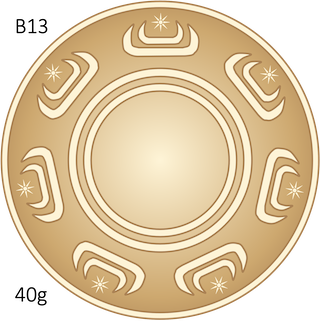
B14 (40i): ~ 250 BC Antigonid – Kallikles
This design is based on shield 40i from Head (1982). Head took this from the Lyson and Kallikles tomb. The shield in the tomb is painted as polished bronze, with thunderbolts between the crescents. Interestingly, there is no symbol in the centre of the shield.
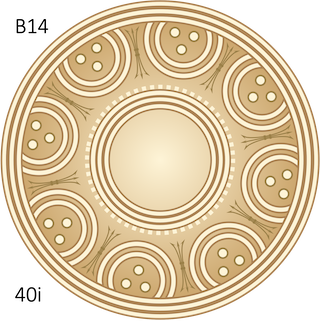
B15: 239-229 BC Antigonid – Demetrius II – Staro Bonce A
The Macedonian royal burial chamber founded near the village Bonche revealed fragments of several shields. Anastasovski (2021) has a reconstruction of one of these. I’ve reproduced the same shield, but in a slightly different manner. This shield carried the inscription ΒΑΣΙΛ ΔΗΜΗΤΡΙΟ (Ruler Demitri) may have belonged to Demetrius II Aetolicus of the Antigonid dynasty (reign 239-229 BC). Notice the rather unique 12 pointed star in the middle.
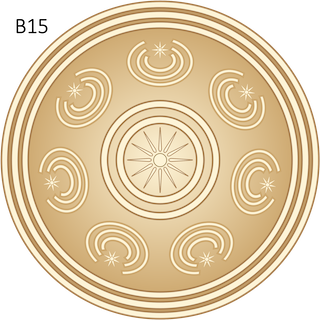
B16: 221–168 BC Antigonid – Philip V and Perseus – Coin with club of Heracles
Macedonian silver tetrobols of King Philip V (221-179 BC) and King Perseus (179-168 BC) often have a shield with a knotted club of Heracles, sometimes alone, but usually bisecting the national inscription MAKE (abbreviating MAKE?ONON).
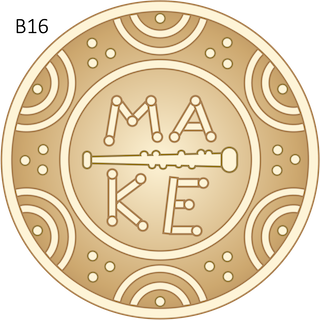
B17 (40h): 221–179 BC Antigonid – coin of Philip V
This design is based on shield 40h from Head (1982). From another coin of Philip, borne by Athene instead of her usual gorgon.
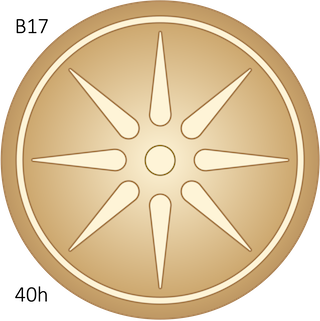
B18 (40m): 179–168 BC Antigonid – Perseus – Coin with Whirlygig
Macedonian silver tetrobols of King Philip V (221-179 BC) and King Perseus (179-168 BC) often have a shield with a whirligig. the whirligig motif may be derived from the star.
The example is from a coin in the district of Amphaxitis of Macedonia, probably from Perseus’s reign (Head, 1982, fig 40m).
I have a photo of a Macedonian Silver Tetrobol with a six ray whirligig, but a different configuration of pellets. I also have a four ray whirlygig from 187-168 BC.

B19 (40k): 168 BC Antigonid – Perseus- Aemilius Paullus
This design is based on shield 40k from Head (1982). Infantry shield from the Aemilius Paullus monument, commemorating Pydna.
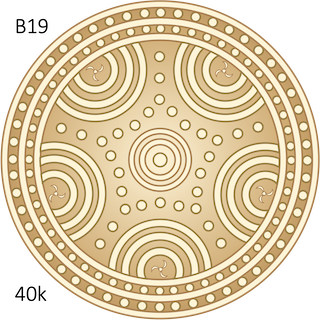
B20 (40l): 168 BC Antigonid – Perseus – Aemilius Paullus
This design is based on shield 40l from Head (1982). Infantry shield from the Aemilius Paullus monument, commemorating Pydna.
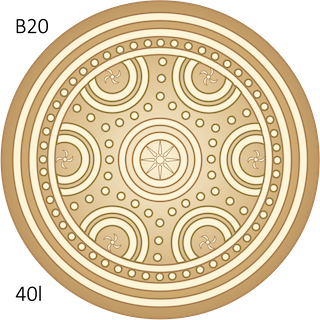
B21 (40n): Post 146 BC Macedonia Prima – Coin
This design is based on shield 40n from Head (1982). Coin from Macedonia Prima, one of the Roman puppet republics formed after Pydna.
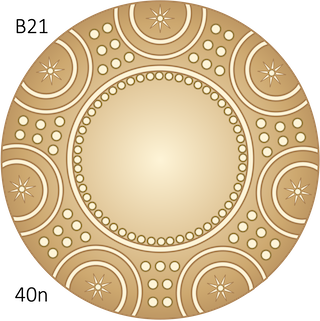
B22 (40o): 281–261 BC Seleucid – Antiochus I Soter – Anchor
This design is based on shield 40o from Head (1982). The source is a Seleucid coin of Antiochos I. Head confirms the anchor was carried this way up (i.e. upside down), citing a coin celebrating a late Seleucid-Ptolemaic alliance where Athene’s shield is blazoned with the anchor and the Ptolemaic eagle.
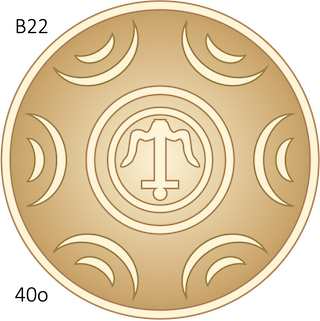
B23 (40p): 175-164 BC Seleucid – Antiochos IV
This design is based on shield 40p from Head (1982). The original coin bore a portrait of Antiochos IV.
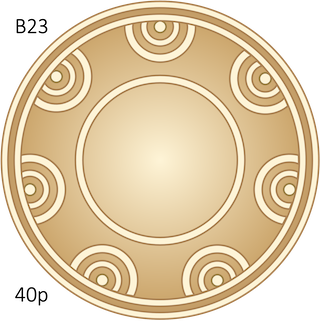
B24 (40t): 159-138 BC Pergamene – Attalus coins
This design is based on shield 40t from Head (1982). Pergamene, from early coins of the town of Philadelphia, founded by Attalos Philadelphos, 159-138 BC
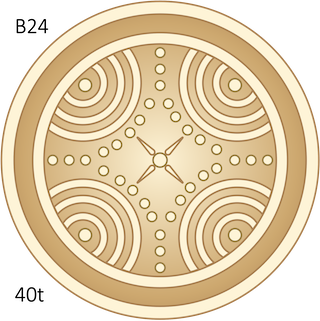
References
Anastasovski, M. (2021, 23 April). The Royal Macedonian shields and the lost city of Pelagon. Macedonian Times.
Head, D. (1982). Armies of the Macedonian and Punic Wars 359 BC to 146 BC. Wargames Research Group.
Karunanithy, D. (2013). The Macedonian War Machine: Neglected aspects of the armies of Philip, Alexander and the Successors 359-281 AD. Pen & Sword Military.
Mestre Gonzalez, C. (2021). The Macedonian army as a vehicle for change? Military presence in western Asia Minor during the early Hellenistic period: topography, agency and identity. Doctoral thesis (Ph.D), UCL (University College London).
Sekunda. N. (1984). The Army of Alexander the Great [Men-at-Arms 148]. Osprey Publishing.
Sekunda. N. (2012). Macedonian Armies after Alexander 323-168 BC [Men-at-Arms 477]. Osprey Publishing.
Sekunda, N. (2013). The Antigonid Army. Gdańsk University.
Vagi, D. (2014). Macedonian shields often depicted on ancient coins. World Coins.
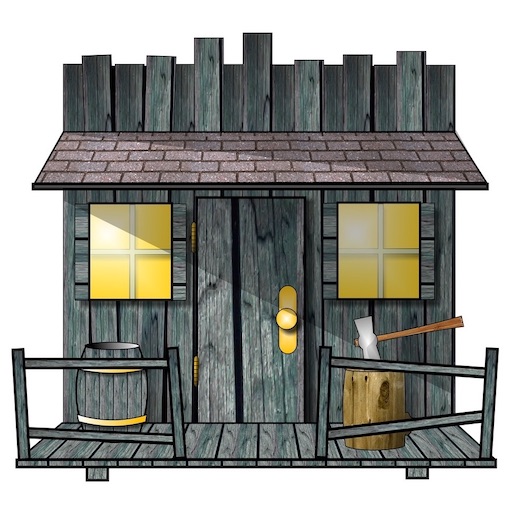

Great work@
I made a copy of the shield patterns then used a graphic arts program to color them, reduce them in size to fit the figures, copied and pasted multiple copies of the patterns I wanted, printed them on card stock, cut them out and then glued them to the figures. Back side was also colored. Much better than the man hole thick shields that come with the figures. I have done this for many other figures including 28mm fantasy.
Some excellent research Steven! There are a few designs that are new to me.
Neil